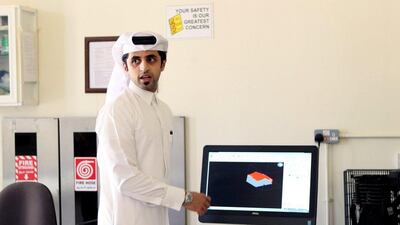Doha // Following concerns over poor quality pitches at Euro 2016, Qatar has employed a high-tech solution to avoid similar criticisms of its World Cup in 2022 -- 3D printers and wind tunnels.
Scientists at Qatar University, the country’s largest higher education establishment, have created 3D-printed models of some of the potential eight stadiums that will be used in 2022, to try and ensure there are no such similar surface problems in six years’ time.
“We are aware of what is happening in Europe,” lead scientist of the research, Saud Ghani said.
“There will be good pitches according to the highest quality of FIFA requirements (in 2022).”
More World Cup 2022
Related: Hosting 2022 World Cup is 'an extra motivation' for Qatar to qualify for Russia 2018
Read also: Qatar could face further World Cup 2022 infrastructure cutbacks
Asked if the models and tunnels will help improve the quality of pitches for the players, Ghani replied emphatically: “Yes.”
The 1:300 scale printed models, which take around a month to assemble, are used to test each stadium’s design, aerodynamics, light and resistance to the Qatari desert climate, as well as the playing surface.
They are then placed in a wind tunnel at the university’s college of engineering’s north Doha base.
Air is then blown onto each model from any required direction.
This air is tracked by laser beams to highlight any potential issues, which could even ultimately mean making changes to a stadium’s design.
So far, models of Al-Bayt and Al-Wakrah stadiums have been recreated. A third -- of the Al-Thumama venue -- is being printed.
The knowledge developed in Doha is also being shared with international sports stadium developers, including those in Belgium, ahead of the next Euros in 2020.
Pitch problems have dogged the Euro 2016 tournament.
The playing surface at Lille, which hosted Germany’s last 16 game with Slovakia, was replaced last Thursday after severe criticism by the Italian and French coaches, Antonio Conte and Didier Deschamps.
The playing surface in Marseille, which will host the quarter-final clash between Poland and Portugal, has also been criticised.
And although the 2022 World Cup is now being played in November and December, the stadiums still have to be strong enough to resist Qatar’s fierce summers.
“They don’t want these stadiums to be white elephants, Qatar wants to use them all year round,” said Ghani.
The college of engineering’s work is being funded in part by the Supreme Committee for Delivery & Legacy, the body organising Qatar 2022.
Ghani won’t say how much is being spent on the research but Qatar’s World Cup is on course to be the costliest ever.
The controversial tournament is expected to cost about $30 billion (27 billion euros, £23 billion), with stadiums accounting for up to $10 billion of that, organisers have said.
Follow us on Twitter @NatSportUAE
Like us on Facebook at facebook.com/TheNationalSport

